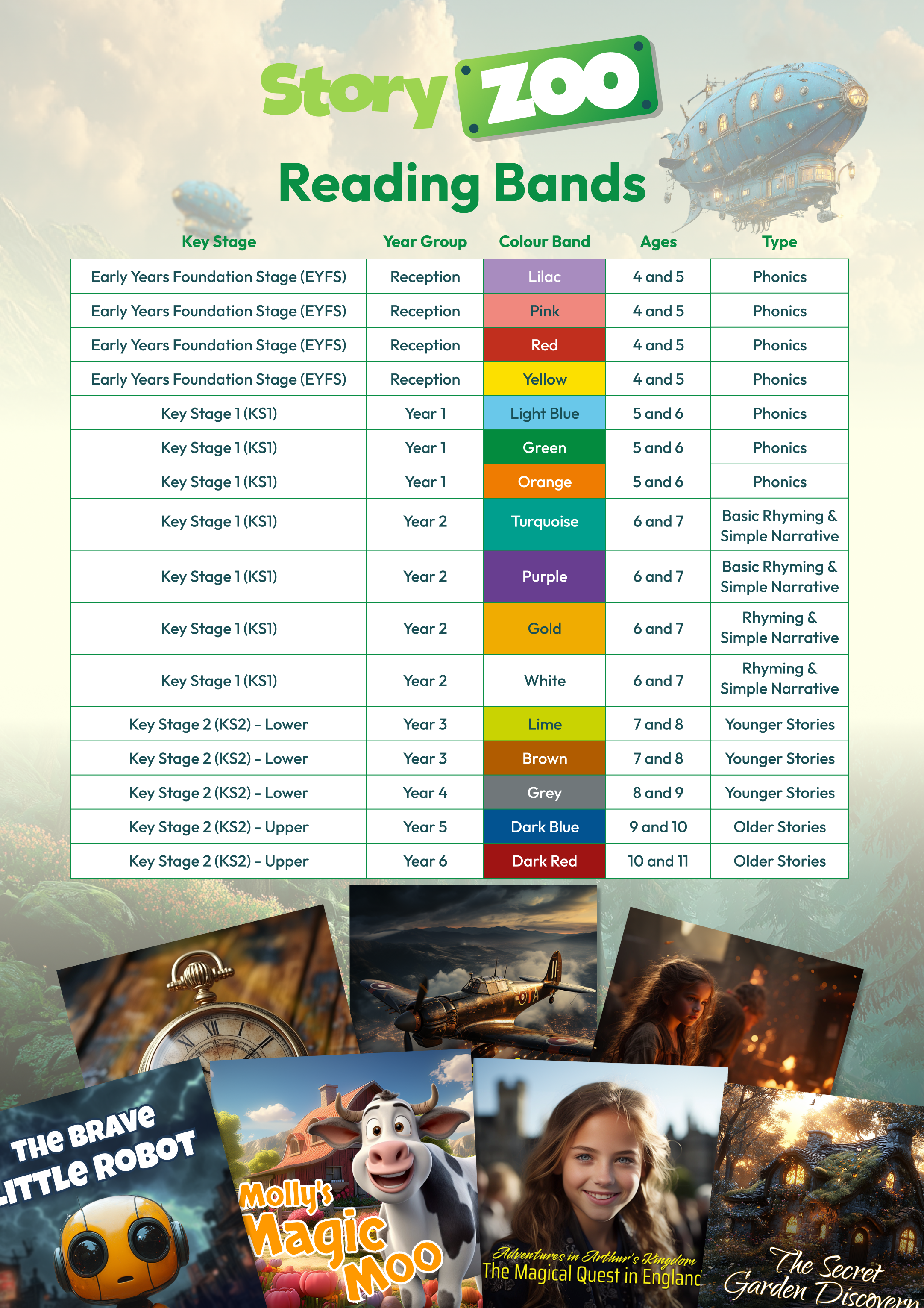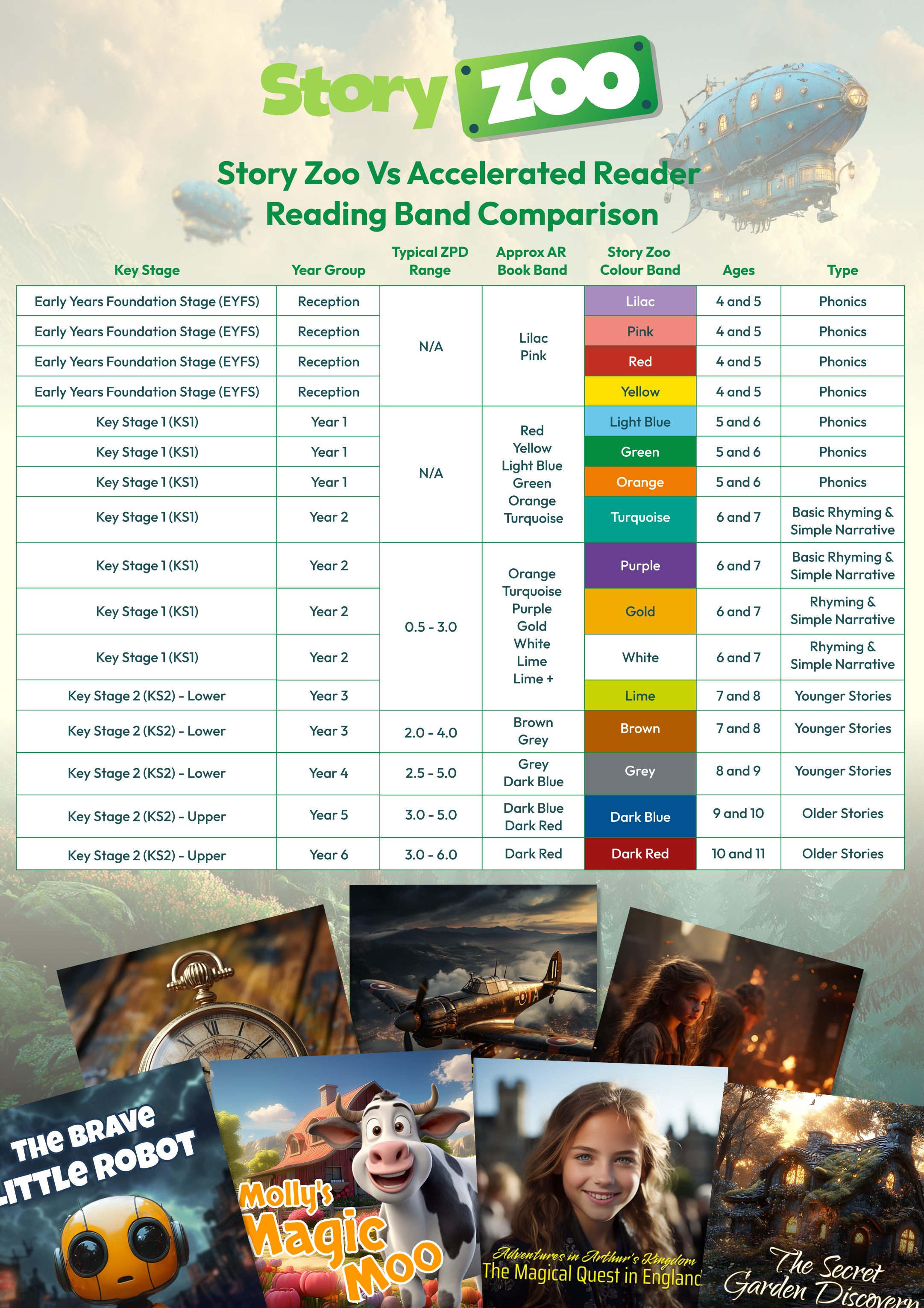How Story Zoo Reading Bands Support UK Schools and Compare to Accelerated Reader and Read Write Inc
Post by: Sophie Hayes
Published: 30 October 2025 • 9 min read
Q&A with Story Zoo Co-Founder and Primary Teacher Sophie Hayes

1. Story Zoo’s reading bands align closely with the UK National Curriculum synthetic phonics schemes. What was your thinking behind designing the banding system in this way, and how does it support teachers in guiding children through progressive reading stages?
We align to any synthetic phonics scheme accredited by the DfE by providing a comparison document for schools. Our early phonics books are colour banded and cover the sound progressions from the earliest stages of phonics teaching. We have mapped phonics sound progression and tricky words for phase two through to 5 so teachers can easily match their existing scheme to Story Zoo bands.
Some phonics schemes teach alternative sounds alongside the initial sounds, so in those cases we sort books accordingly and provide schools with a comparison guide. This means teachers can look at the child’s current scheme and see exactly how that translates to the matching Story Zoo colour band.
We made a conscious decision not to use overly rigid levels. In my experience, restricting a child’s choice too tightly often reduces their love of reading. Many children lose enthusiasm when they only ever choose between the same two or three books. We want children to have a decodable book aligned to their synthetic phonics scheme, which they can also log and quiz on Story Zoo, but we also want to offer them a much wider choice of genres to encourage reading for pleasure.
By giving children access to a wider colour band, we allow them to pick books they enjoy and can decode, while still giving teachers structure. Once children move past phonics, we offer curriculum aligned non fiction based on topics in the National Curriculum, including ambitious vocabulary. We also have fiction books based on those curriculum themes to give children a richer understanding when learning subjects like history and geography. We find these books really help when teaching different history and geography, topics as the children, get a more well-rounded view of those events.

2. Schools often already use systems like Accelerated Reader or Read Write Inc. How does StoryZoo’s banding system map across to these programmes, and how have you made it easy for teachers and SLT to understand the comparison?
We have created structured comparison documents for the most commonly used phonics schemes and we continue to expand them as we work with more schools. Teachers can simply look at a child’s phonics stage and immediately see the Story Zoo colour band that aligns.
It creates a really easy transition and the familiar colour banding helps with teachers. It’s easy to follow along and makes sense to teachers, children and parents.
We also offer comprehensive support so we can come in and train staff. We offer parent workshops and we also come in and do school workshops with the children. This allows for a really easy handover process and, as a teacher myself, I want to take the strain off of teachers using new software. I understand the hesitancy sometimes of implementing a new software because it increases the workload of a teacher. However, at Story Zoo, that's the opposite of what we want to create.
We really believe in our product and we know that it's going to help children to develop a love of reading and to increase their engagement and their attainment. To do that, we ensure that the handover process between competitors and us is as smooth as possible by making sure that we provide all the documents to help align ourselves with synthetic phonics schemes. We can be used in addition to those to enhance a child's library, while still meeting all of the OFSTED regulations as well.

3. Accelerated Reader and Read Write Inc both have strong reputations, but they are also very structured and can feel restrictive. How does Story Zoo combine structured reading progression with freedom of choice to build genuine reading pleasure and higher engagement?
When researching Story Zoo, I wanted to avoid the restrictive feel that some very structured systems create. Many children and staff had product fatigue and children were limited to a tiny range of books. That can create negative reading experiences and stop children exploring wider genres.
Our approach focuses on reading for pleasure because it is an evidence-based driver of attainment. In Story Zoo schools, when we improve engagement and reading for pleasure, we see attainment rise too. Children read more when they are excited by books, exposed to different genres and encouraged to explore their interests.
We build progression and structure, but we also protect choice and enjoyment which are essential for long-term success.

4. Many SLTs are focused on raising literacy outcomes while also managing budget and workload pressures. How does Story Zoo’s banding approach and book library help children make faster progress in reading while easing teacher workload?
Our comparison documents mean teachers can level books quickly and confidently. It is simple to see which Story Zoo colour band matches each child’s reading stage.
Progress tracking is automated, so teachers and SLT can monitor both engagement and attainment instantly. Reading often relies on teacher judgement alone, which is invaluable, but combining that with clear data gives a holistic understanding of progress. We also show which books children enjoy and suggest others based on their interests, strengthening reading for pleasure.

Our library gives every child access to hundreds of quality fiction and non-fiction books. For many children who do not have many books at home, this levels the playing field and supports social mobility. Story Zoo offers this at a fraction of the price of some competitors, making it accessible for schools while delivering strong impact.
We provide full staff training led by qualified teachers, delivered in person or virtually. This ensures staff can use the platform effectively without extra workload. Schools get real value for money and children get the full benefit of the programme.
Author

My name is Sophie Hayes and I'm a qualified primary school teacher with a deep passion for nurturing young minds and fostering a love for reading. With two energetic primary school-aged children of my own, I understand the delicate balance of juggling work, home life, and raising two inquisitive, busy minds!